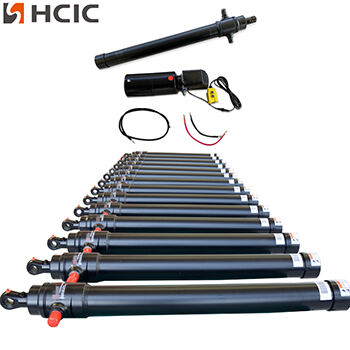Hydraulic cylinders are critical components in many industries to enable the operation of heavy machinery such as excavators and cranes etc. These cylinders are machines which convert fluid power into linear mechanical force - essential for the operation of many different types of machinery. But, like any other machine part, hydraulic cylinders could deteriorate in performance due to overuse. Thus, regular maintenance and checking of hydraulic cylinders is an essential requirement to ensure that they deliver optimally and do not lead to expensive breakdowns.
Testing Your Hydraulic Cylinder
To get to that point, there are a few things you need to know about the construction and operation of your hydraulic cylinder before testing it. One: the hydraulic cylinder is composed of several important parts, including a hollow cylinder barrel; one or more piston(s), fitted with two seals heads Between every unit included in the head can be done to slide into any installation,the physical structure between these plates makes it possible to perform a contact between blade and Gland systems. Nobody had a clue where the barrel which contained hydraulic oil under great pressure to expand and contract that would result in pushing out such power - no idea from one block over, let alone 700 miles.
A primary means of assessing the operational condition a hydraulic cylinder is to examine its external appearances. Keep an eye out for external leaks and damage - check mounting of the piston rod into cylinder barrel, mountings to see if any gland is pushed aside. Leaks might indicate that you've been losing hydraulic fluid, which can ctually cause performance issues and equipment eventual failure. Any broken external parts are indicative of internal issues, such as oil seals that have been worn out and fluid contamination.
Also, it is very important to test cylinder actuation. It is operating the machinery connected to cylinder through several cycles and inspecting whether there are any irregularities like misalignments, jerky movements or abnormal noises. This may suggest that there is some frictions, an internal impairment or misaligned parts. It is important to guarantee that the cylinder moves smoothly and work well with equipment.
How to Get Your Hydraulic Cylinder TestedTailored Solutions For Evaluating The Performance Of AHydraulicimiters
Besides testing whether the cylinder can still perform as it should, there are three measures to determine its performance-level. You should begin with verifying hydraulic fluid level and quality to prevent low or contaminated fluid related problems. Check that the in and out is what the manufacturer has specified, to prevent loss of pressure which can affect performance. Another critical part here is you want to keep the hydraulic pressure within its operating capability or else your going to damage some seals and possibly equipment.
Finally, these are based upon the stroke length of the cylinder (how far out and back in again does that piston rod travel within its bore). Any variations in stroke length may detect an internal damage altering the operation of the equipment. Keeping an eye on such factors would help to identify and rectify any possible complications before they can become big issues.
Common Troubleshooting
There are many problems hydraulic cylinders can encounter that will affect their operation. Steps to recognize and test these problems are essential for a healthy system. Cylinder drift is a major concern and refers to the movement of piston rod when not actuated due to internal leakage. Cylinder drift test: This involves the use of a flow meter to compare measured with standard flows - deviations call for remedial action.
Rod scoring is defined as the scratches or grooves on the surface of piston rod, another disease that should be observed. Rod scoring can be detected before it becomes too severe through visual inspection and the careful use of a thickness gauge, allowing corrective action to address an issue that could otherwise spiral out of hand.
Accurate Test Tool & Techniques
The images to the right show different tools a methods. Vertical table Upstrokeocator Actutelevision Model 505, Majacraft Mfg. Using tools such as flow meters for flow rate and pressure measurements can help you to identify cylinder drift, track performance at different levels of pressure. Hydraulic pressure is so important to a cylinder and monitoring the internal hydraulic pressures are through those measured with interior or attached gauges. A thickness gauge and micrometer necessary to measure the piston rod diameter for scoring, cracks or warpage.
Inspection is still the most cost-effective way to test hydraulic cylinders, especially on visible features: piston rod, cylinder barrel and gland. Testing, in addition to the above-referenced good maintenance and fluid management practices is what we need for long-lasting hydraulic cylinders that won't fail us when we least expect it.
Regular testing of hydraulic cylinders is necessary for maintaining long term performance and avoiding equipment failure. The correct testing application and preventive strategies can help eliminate several common problems thereby keeping the hydraulic cylinders in top working condition longer, saving on expensive repairs. We encourage the dedication of keeping our hydraulic systems in top health, for properly working machines.

 EN
EN
 AR
AR
 BG
BG
 HR
HR
 CS
CS
 DA
DA
 NL
NL
 FI
FI
 FR
FR
 DE
DE
 EL
EL
 HI
HI
 IT
IT
 JA
JA
 KO
KO
 NO
NO
 PL
PL
 PT
PT
 RO
RO
 RU
RU
 ES
ES
 SV
SV
 CA
CA
 TL
TL
 IW
IW
 ID
ID
 LV
LV
 LT
LT
 SR
SR
 SK
SK
 UK
UK
 VI
VI
 HU
HU
 TH
TH
 TR
TR
 FA
FA
 MS
MS
 GA
GA
 CY
CY
 KA
KA


